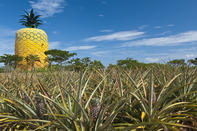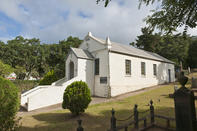Giant Pineapple in Bathurst
No, that's not a cell phone tower disguised as a pineapple in Bathurst. It's a tribute to this tasty fruit, which saved the early farmers in this part of the Eastern Cape who'd not had much success growing anything before a farmer called Charles Purdon planted a pineapple top in 1865.

He'd got it from a barber in Grahamstown who'd grown them to give his customers something to talk about (this was before Discovery Channel). The observation deck offers magnificent 360° views over the surrounding farmlands to the Indian Ocean.
Today the town of Bathurst brings together the past and the present, being the hub of one of the largest pineapple growing areas in South Africa. One of the country's most extensive collections of early agricultural implements can be seen in the Bathurst Agricultural Museum.
The Bathurst district is noted for its pineapple farms, and the 16 m-high giant pineapple on Summerhill Farm is a well-known landmark. The structure offers fine views of the farm, while an audiovisual presentation provides information on the history and cultivation of this fruit. Children in the area are often seen selling handmade windmills.
Historic Buildings of Bathurst

The town of Bathurst in the Eastern Cape, has a number of old buildings with a rich heritage. The oldest Anglican church building in South Africa is St. John's in the town.
The Methodist church was built by settler Samuel Bradshaw and was opened in 1832. It was originally constructed with a thatch roof, and a porch was added later. There is also an old ammunition store in town that was used during the frontier wars. The original Bathurst Forge was built in 1821 by Thomas Hartley. In 1831 it was converted into a pub, which became the oldest licensed inn of South Africa.
A few of the first houses built in Bathurst still stands today. Morley House is an exquisite historic home with yellowwood woodwork, red-baked floor tiles, crooked passages and low doorways. It dates back to the 1820s.
Bradshaw's Mill
Bradshaw’s Mill in Bathurst is situated on the banks of Bathurst River. This National Monument was built by British settler Samuel Bradshaw in 1821. He intended to use it to manufacture blankets and kersey cloth. As a result, Bathurst became the wool industry hub in the mid-1820s.
Unfortunately, the mill was burned down in 1835 by Xhosa warriors, but it was rebuilt a year later. The mill was then used for grain, and use was discontinued in the 1900s. In 1964 it was bought by the Simon van der Stel foundation. The foundation restored it in 1981 and today it stands as a reminder of the area’s rich history and fascinating heritage.
A Toposcope
In Bathurst there's a toposcope (a monument that is dedicated to people or past events) on the spot from which the farms allocated to the 1820 British settlers were surveyed. The stones of the toposcope were recycled from old settler homes. While you're enjoying the view, imagine yourself as one of the 4 500 settlers (who were mainly traders or craftsmen) dumped as a human shield in a frontier war, on 100 acres without even a Do It Yourself (DIY) farming handbook.